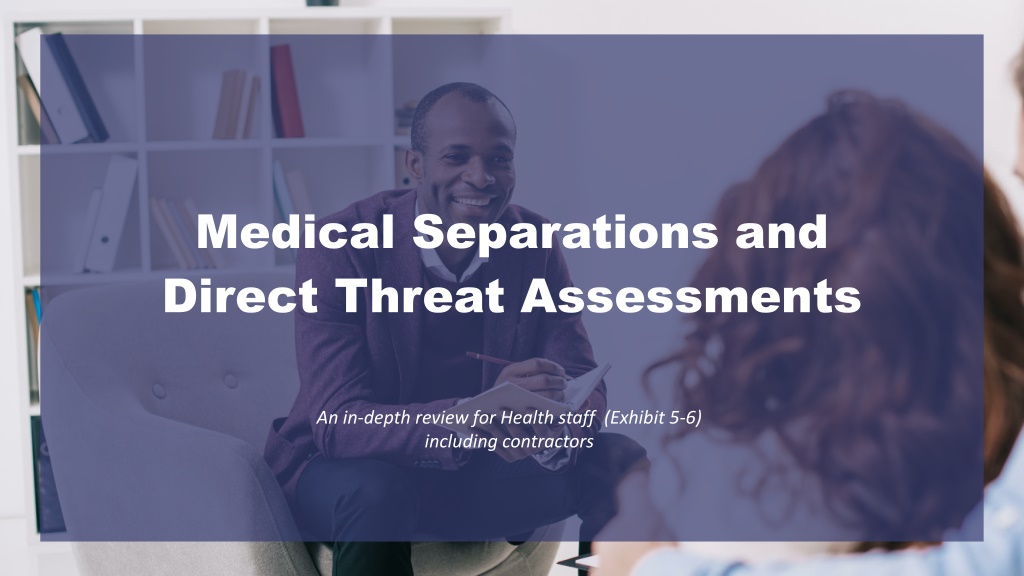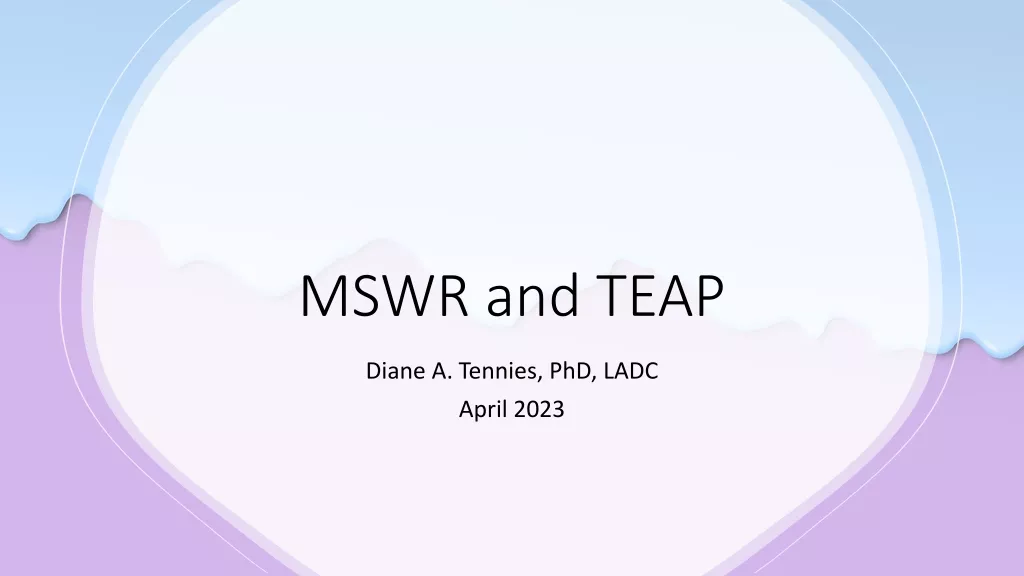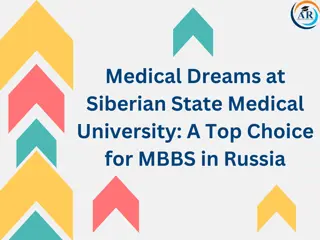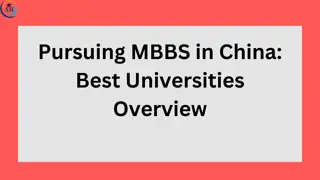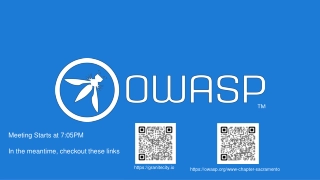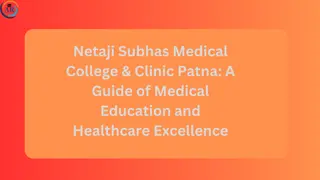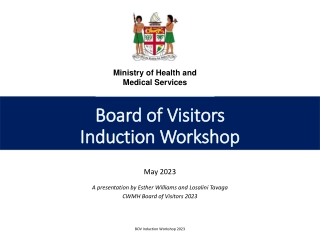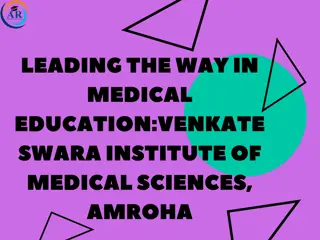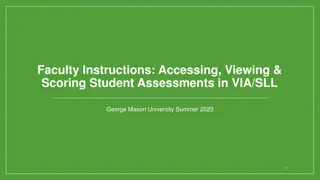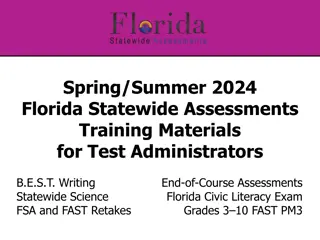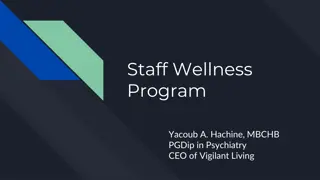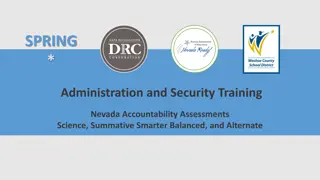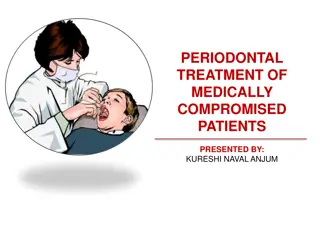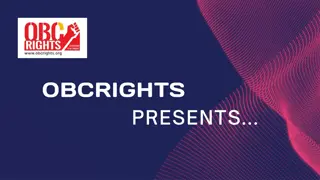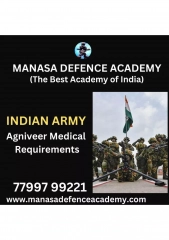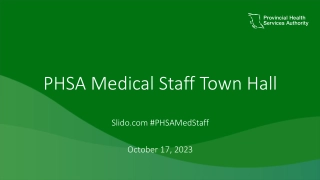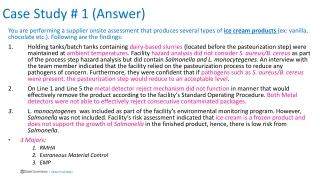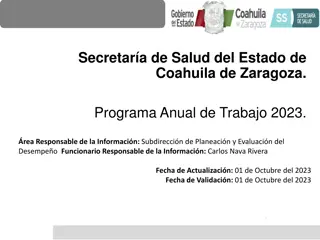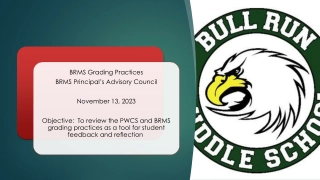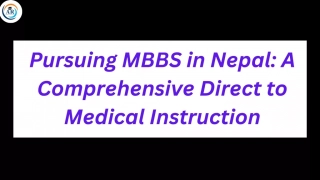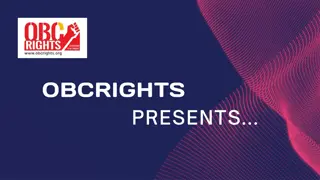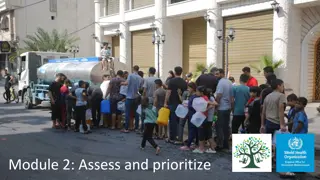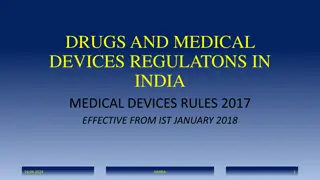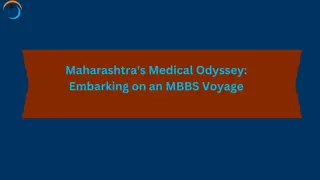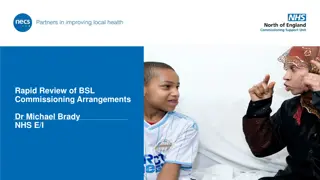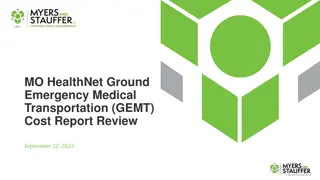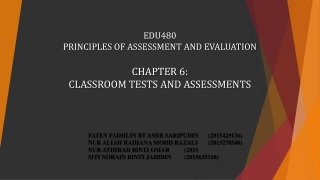Comprehensive Review on Medical Separations and Direct Threat Assessments for Health Staff
This resource provides an extensive overview of medical separations and direct threat assessments relevant to Job Corps health and wellness staff and subcontractors. It covers topics such as the process of medical separations, reinstatement rights, disability accommodation, and when medical separations should be considered as a last resort. The focus is on equipping health personnel with updated policies, practices, and forms for effective decision-making in handling medical conditions impacting Job Corps participation.
Comprehensive Review on Medical Separations and Direct Threat Assessments for Health Staff
PowerPoint presentation about 'Comprehensive Review on Medical Separations and Direct Threat Assessments for Health Staff'. This presentation describes the topic on This resource provides an extensive overview of medical separations and direct threat assessments relevant to Job Corps health and wellness staff and subcontractors. It covers topics such as the process of medical separations, reinstatement rights, disability accommodation, and when medical separations should be considered as a last resort. The focus is on equipping health personnel with updated policies, practices, and forms for effective decision-making in handling medical conditions impacting Job Corps participation.. Download this presentation absolutely free.
Presentation Transcript
Medical Separations and Direct Threat Assessments An in-depth review for Health staff (Exhibit 5-6) including contractors
01 01 Medical Separations 02 02 Medical Separations with Reinstatement Rights AGENDA 03 03 Direct Threat Assessments Disability Accommodation as a part of Medical Separations and Direct Threat Assessments will be discussed in each applicable section. 2
Purpose Purpose This training provides an in-depth review geared specifically to Job Corps Health and Wellness staff and subcontractors. Participants will receive a deep dive into the new policies, practices, and associated forms. Special focus will be given to the revisions of Form 2-04 Individualized Assessment of Possible Direct Threat. 3
Medical Medical Separations Separations PRH Chapter 6, Section 6.2 R5 4
Medical Separation Medical Separation Overview Overview When Do Medical Separations Occur? A medical separation occurs when a student is no longer able to participate in Job Corps due to medical conditions (including pregnancy-related conditions, dental conditions, substance use conditions, or mental health conditions). 5
Medical Separation Medical Separation Overview Overview (cont.) (cont.) What Type of Separation Occurs First? At the time of medical separation, the student is always first separated as a Medical Separation with Reinstatement Rights (MSWR). They may be reinstated into the Job Corps within 180 days. A regular medical separation is given only if reinstatement following the MSWR does not occur. 6
Medical Separations Medical Separations are a are a Last Resort! Last Resort! Medical separations must only be used as a last resort, after Other methods of addressing the relevant medical concerns have been tried or considered in each individual case and determined to be insufficient Administrative Leave with Pay Personal Leave with Pay and/or Other types of leave 7
Medical Separation Medical Separation Qualified Providers Qualified Providers Qualified licensed/certified health providers include: Medical separations must be documented in the student health record by a qualified licensed/certified health provider. Medical separations must be initiated by health services staff. Center Physicians/Nurse Practitioners/Physician Assistants Center Mental Health Consultants (CMHCs) Center Dentists Trainee Employee Assistance Program (TEAP) Specialists Student s treating provider or outside specialist 8
Medical Separation Considerations A medical separation may be considered when the appropriate qualified health professional has determined the student to have a preexisting or acquired health condition that requires treatment beyond the basic health services provided by Job Corps; AND The necessary treatment is unavailable or will be unusually costly to Job Corps; AND Administrative Leave with Pay, Personal Leave with Pay, other types of leave, and other methods of addressing relevant medical concerns without resorting to separation have been tried or considered in each individual case and determined to be insufficient. 9
Medical Separation Medical Separation Considerations Considerations (cont.) (cont.) Medical separations must not be used in lieu of providing disability accommodations (i.e., reasonable accommodation, reasonable modification in policies, practices, or procedures, and auxiliary aids and services) including equally effective communications for individuals with disabilities. Disability accommodations must be tried or considered with the goal of allowing the student to participate in the Job Corps program to the maximum extent possible. Medical separations must not be based on stereotypes regarding certain disabilities or speculation regarding their management or associated expense. 10
The Health and Wellness Director will complete the Center Applicant/Student File Review Form (which is found in Form 2-04 Direct Threat Assessment) if the Center s HWD has a Medical Separations for Direct Threat reasonable belief, based on objective evidence, that the student has a medical condition or disability that may pose a significant risk of substantial harm to the health or safety of others. Then the HWD will refer the student to a qualified health professional who has current, documented expertise in the medical condition or disability involved. The Direct Threat Assessment (Form 2-04) must be completed in order to determine whether a medical separation is appropriate. 11
The HWD will refer the student to a qualified health professional who has current, documented expertise in the medical condition or disability involved if the Center s HWD has a Medical Separations for Health Care Needs reasonable belief, based on objective evidence, that the student has a medical, mental health, oral health, and/or substance abuse treatment/ monitoring need that presents a significant barrier to continued participation that cannot be addressed through reasonable accommodation, reasonable modification in policies, practices or procedures, and auxiliary aids and services. Detailed Health Care Needs Assessment training will be provided at a later date. 12
Medical Separation Requirements Medical Separation Requirements Health staff must approve all transportation plans and if an escort is needed. Health and social service written referrals must be provided to medically separated students. Students must be followed up monthly by the Health and Wellness Director while separated. Documentation of monthly follow up must be in the student health record. 13
Medical Separation Medical Separation Documentation Documentation Documentation for a medical separation in the student health record must include at a minimum: The clinical assessment for separation, including current symptoms/behaviors and functional impairments and a diagnostic code; Individualized treatment instructions; Student consent; Referral source(s); Transportation details, including whether an escort is needed; Dates of separation and anticipated return to center; Individualized student medical expectations to return; and If the student is an individual with a disability, a copy of any accommodation plan and CIS Accommodation Plan Notes tab documentation. 14
Medical Separation Extensions Documentation The request should be accompanied by supporting documentation from the student s health-care provider verifying that extension of leave is medically necessary. Request Extension Center staff must submit a request to the Regional Office to extend a MSWR beyond 180 days for extenuating circumstances and/or if there is a request for disability accommodation related to a change in the date of the student s return. Individualized Requests will be reviewed on a case-by- case basis. 16
Direct Threat Direct Threat Assessments Assessments PRH Chapter 2, Form 2-04 17
Threat to Others Legislative updates to direct threat language occurred in 2017 and required modification of existing PRH policies to ensure compliance with Section 188 of the Workforce Innovation and Opportunity Act, Section 504 of the Rehabilitation Act of 1973, and related implementing regulations. Direct threat to self or others is now direct threat to others. 18
Direct Threat Direct Threat Defined Defined Federal disability nondiscrimination laws define a direct threat as a significant risk of substantial harm to the health or safety of others that cannot be eliminated or reduced by reasonable accommodation, reasonable modification in policies, practices, or procedures, and auxiliary aids and services. 19
Significant Risk Qualification A significant risk means a high, not a slight, probability of risk; A speculative or remote risk is insufficient. 20
Applicants + Students Enrolled Students? Applicants? Applicants? OR Now the form has been expanded to include both applicants and enrolled students. Form 2-04 was previously for applicants only. 21
Direct Threat Direct Threat Considerations Considerations Direct threat may be considered if there is reasonable belief, based on objective evidence, that the individual has a medical condition or disability that may pose a significant risk of substantial harm to the health or safety of others. Threat to self is no longer part of the definition of direct threat. Direct Threat Assessments, Policy and Requirement Handbook Form 2-04, may be considered for applicants as part of the Applicant File Review process and for students as part of the medical separation process. 22
Qualifying Qualifying Standard Standard Job Corps requires, as a qualification standard, that an applicant or student not pose a direct threat to the health or safety of others, including students and staff. Like any qualification standard, this requirement must apply to all applicants and students, not just to those with disabilities. 23
Applicant and Student Processes Applicant File Review Process Documenting Initial Reviews Records Manager receives applicant file in CIS and logs on AFR Tracking Log. The initial review of applicant files must be documented on the new Center Applicant File Review Form in PRH Form 1-06 for Health Care Needs or the Center Applicant/Student File Review Form for Direct Threat which is included with Form 2-04 Direct Threat Assessment. The Health and Wellness Director (HWD) is the File Review Coordinator for the center and completes a general review of medical and disability-related documentation and the Job Corps Health Questionnaire (ETA 653). 24
Applicant and Student Processes Student Medical Separation Process Initiated by Center Physician, Center Mental Health Consultant, or other appropriate qualified health professionals (including the student s individual treating provider). Student has a preexisting/acquired health condition that requires treatment beyond the basic health services provided by Job Corps and: Treatment is unavailable or will be unusually costly to Job Corps; and ALL leave and other methods have been tried or considered in each individual case and determined to be insufficient. If the student is an individual with a disability, the center with the student, via an interactive disability accommodation process, has considered whether any disability accommodations would address or mitigate any concerns, to allow the student to participate in the Job Corps program to the maximum extent possible. 25
Reasonable Belief A DTA should be conducted if the HWD has a reasonable belief, based on objective evidence, that an individual applicant or student has a medical condition or disability that may pose a significant risk of substantial harm to the health or safety of others. 26
The fact that an individual has been referred for a direct threat assessment does not necessarily indicate that they will be determined to be a direct threat. 27
Clinical Clinical Assessment Assessment APPLICANTS AND STUDENTS A center may need to consult with the individual s treating provider or may need to retain an outside provider with the necessary current expertise in the particular medical condition or disability and its effects, to conduct a direct threat assessment in a given case. General medical expertise, without expertise in the specific medical condition(s) or disabilities at issue in a given case, is insufficient. The clinical assessment of direct threat must only be determined by qualified health professionals who have current, documented expertise in the medical condition(s) or disability or disabilities involved in a particular case. 28
Form 2-04 Direct Threat Assessment The qualified licensed health professional begins the completion of the direct threat assessment. 29
Effective Communication Appendix 201 Communicating with Individuals with Disabilities Obligation is separate from reasonable accommodation or modification. Required if needed to participate in the clinical interview or disability accommodation process. Must be documented on the assessment. 30
What factors triggered the review of the individual s file for possible direct threat to others? 01 Determination of Determination of Direct Threat Direct Threat As part of the determination of direct threat, the qualified health professional must consider: Include responses from ETA 653 (applicants), information from applicant file/student health record, clinical interview and/or health providers (applicants/students) 31
Determination of Direct Threat Determination of Direct Threat What are the specific symptoms and behaviors related to the medical condition or disability considered to potentially pose a direct threat to others? What is the nature and severity of the potential harm to others (e.g., death, incapacitation, serious injury, minor injury/emotional distress)? 02 03 Nature is what kind of harm to others? Severity is related to the frequency and seriousness of harm? Include information from the CCMPs, applicant file/student health record, education records, clinical interview and/or other health providers or staff if applicable. Do not rely on diagnoses alone. Describe the specific symptoms and behaviors in detail. 32
Determination of Direct Threat Determination of Direct Threat 04 05 What is the imminence of the potential harm (i.e., how soon is the harm likely to occur)? What is the duration of the risk (i.e., how long will the risk last)? The harm to others must be serious and likely to occur, not remote and speculative. Give your best clinical judgment on how soon the harm to others may occur. Are the symptoms and behaviors that pose a risk to others acute/short, chronic/on-going, etc.? Include information from the CCMPs, applicant file/student health record, education records, clinical interview and/or other providers or staff if applicable. Include information from the CCMPs, applicant file/student health record, education records, clinical interview and/or other providers or staff if applicable. 33
Applicant File Review Process 34
Where to Start? CCMPs ETA 653 Center clinicians check the ETA 653 Job Corps Health Questionnaire to see which items were endorsed, any additional comments regarding items endorsed, and if there is any supporting documentation for each item. (May need to request records). Check to see if there are Chronic Care Management Plans (CCMPs) and if the provider(s) recommended applicant for Job Corps. The center clinicians must contact provider(s) if there are conflicting recommendations. 35
FIRST WEEK OF APPLICANT FILE REVIEW REVIEW ALL RECORDS Make notes of disclosed conditions on ETA 653, in health records, and in school disability documents in case applicant interview is needed. SCHEDULE APPLICANT INTERVIEW: If unable to reach applicant after 2 attempts (try all numbers on the data sheet), contact Outreach and Admissions for assistance. OBTAIN NEEDED RECORDS: Fax authorization(s). If no records after 2 attempts (faxes, phone calls), continue assessment with available info. CALL CCMP PROVIDER(S): If unable to reach provider(s) after 2 attempts, continue assessment with available info. Document all activities & attempts to reach applicant, provider and Outreach and Admissions. 36
Applicant Interview is Key! Interactive and 1:1 Single most important part of the clinical assessment particularly if there are no records and no CCMP. Should be conducted with applicant alone (in whole or in part). For minors, parents/guardians should be invited to participate. Even then, you should request for some part of the interview to be with the applicant alone. 37
In person, Telephone or Videoconference A B C Only specific questions may be asked regarding any conditions, symptoms or behaviors that have been disclosed or documented anywhere in the applicant file. See new Sample Interview Questions -- specifically designed to ask about current behaviors/ symptoms and functional limitations. Specific behavioral or clinical observations from interview should be documented. 38
Mental Status Exam (MSE) Specific behaviors and clinical observations made during the clinician s time with the applicant are documented. Yellow highlighting indicates which areas can be assessed during a telephone interview. In Sample Applicant Interview. 39
Direct Threat to Others? 06 40
Student Medical Separation Process 41
Where to Start? Review SIR and/or Incident Report CIS Case Notes Documentation in SHR Check relevant information in the SHR which may include: Check to see if an incident on center prompted the concern about danger to others. Check to see if there are case notes that may describe behaviors on center and interactions with staff and other students. ETA 653 CCMPs Mental Health Notes Any psychiatric or psychological evaluations SF-600 Chronological Record 42
Student Interview Student may or may not be available for interview if danger to others behavior resulted in immediate removal from center. Should be conducted with student as soon as possible on center or via telephone/telehealth options if off center. There must be an interactive student interview! Documentation of efforts to schedule and complete student interview. 43
Same Interview Guidelines for Applicants and Students Only specific questions may be asked regarding any conditions, symptoms or behaviors that have been observed, demonstrated, disclosed, or documented anywhere in the student health record. Focus on current behaviors/ symptoms and functional limitations. Specific behavioral or clinical observations from interview should be documented. Completion of Mental Status Exam. 44
Direct Threat to Others? 06 45
Direct Threat? No Enroll When to Consider Disability Accommodation? YES Submit Person with a disability? recommendation of denial to the Regional Office. No YES Consider disability accommodation. 46
Disability Disability Accommodation Accommodation Considerations Considerations If, it is determined that an individual poses a direct threat as a result of a medical condition or disability, the qualified health professional conducting the assessment must determine whether a disability accommodation would either eliminate the risk or reduce it to an acceptable level. Every effort should be made to identify appropriate disability accommodations that may eliminate or reduce the risk in a given case. 47
Post Direct Threat Assessment 07 Person with a Disability? Lorem ipsum dolor Lorem ipsum dolor The qualified health professional, in collaboration with the DC, must consider reasonable accommodations that may eliminate or reduce the risk sufficiently to allow for enrollment. 48
Disability Accommodation The qualified health professional completing the assessment, in collaboration with the Disability Coordinator identifies disability accommodations that are likely to reduce the level of risk including considerations of requested accommodations from either the applicant/student or others on their behalf. 49
Applicant/Student Responses Accepts The applicant/student accepts the accommodation. Declines The applicant/student declines or refuses the accommodation. 50
